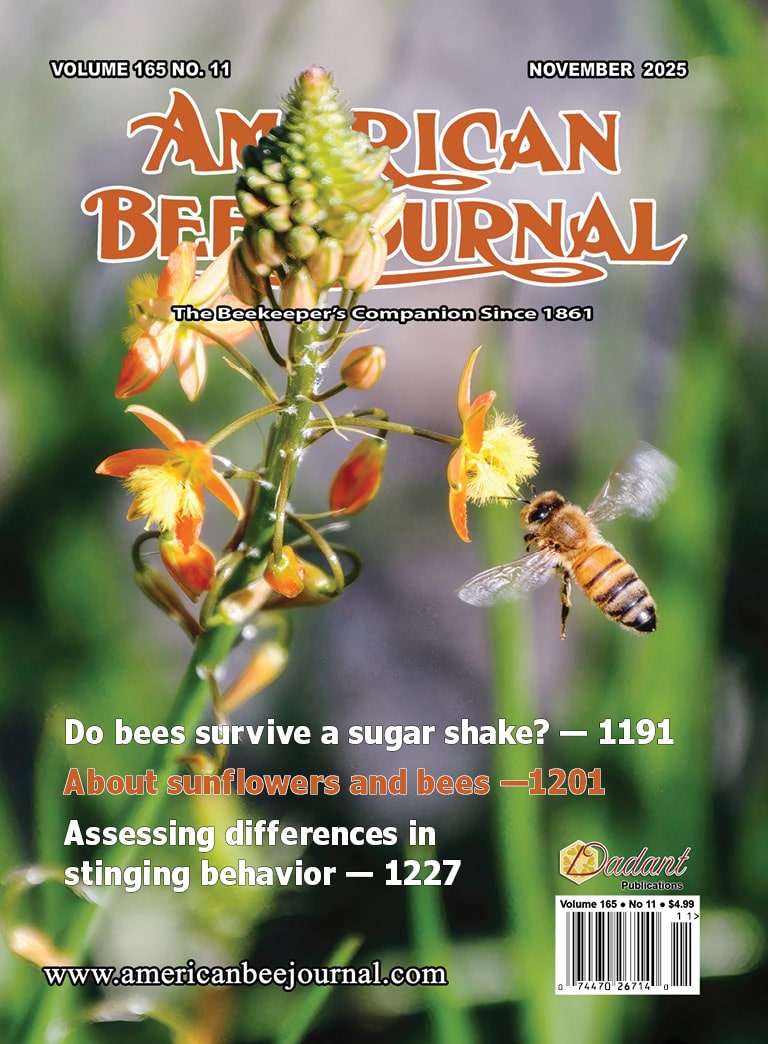
Q: Bees Scenting Brood Cells
I recently was told during a honey bee biology class that the workers scent the brood cells they want the queen to lay in by marking them with pheromones. This kind of makes sense to me since you always see queens investigating several brood cells before deciding to lay in one. I also always wondered how the bees get the queen to lay in queen cups developed for swarming. This theory also seems to make sense if the bees have marked the cups with a pheromone. This would also make sense on how the workers control how many drones are raised. I tried to do a Google Scholar search but could not find anything. Maybe I was using the wrong keywords in my search. I am wondering how someone would have determined this since pheromones are very volatile and you would have to know what pheromone you are looking for. Have you ever heard of this? If so, is there a study out there? I hate to repeat something to someone in my teachings if I do not know there is proof out there.
Regina Rhoa
Pennsylvania, December
A
This is a curious one. I conducted a literature review to look for this information. I have never heard of this in the past and I could not find anything to support it now. Like you, it is entirely possible that I used the wrong keywords. However, even Google’s Generative AI said: “There’s no evidence to suggest that worker bees mark cells in any way to indicate where the queen should lay eggs.” If Google said it, it must be true. 😊 In all seriousness, I would ask the class instructor for a source for that statement. I am happy to believe it happens, but I need the evidence to convince me.
Q: Several Questions
There were two statements in the February classroom that seem to contradict each other.
Calum Grigor wrote, “Letting the drone brood, especially multiple generations of drone brood, hatch will very negatively affect a colony’s Varroa population.” [E.g., more drones, more Varroa, thus the Varroa population goes up — a positive effect on that population, not negative.] You then responded, “You are 100% correct. Using drone comb to produce more drones will almost certainly result in higher Varroa population …” [again, a positive effect on the Varroa population]. Those statements are confusing.
Also, now the swarm time is approaching, I wondered about homemade swarm lures. Is a “reliable” recipe available?
And last, I wondered about the best way to replace frames in the hive. I feel bad about taking old frames out, because they have brood and honey in them; but it seems that it needs to be done. What do you suggest as the “best” way to proceed?
Bob Dye
Missouri, February
A
Question 1: You are correct that the statements appear to contradict one another. However, I think what Calum meant, and certainly the way I answered the question, is that letting drone brood hatch will increase Varroa populations in the nest, thus having a negative effect on the colony. This is reinforced by Calum’s last statement: “I was trying to do exactly this in a local area, with the associated spike in Varroa population, and had to take remedial measures that negatively impacted my honey crop.”
Calum viewed the associated increase in Varroa numbers as a negative that needed to be addressed. As you note, if more drones lead to more Varroa, then you do get a positive correlation (when one goes up, the other goes up). However, I believe Calum meant that this would negatively impact the colony rather than the Varroa population. Either way, promoting the production of drones in one’s colonies will likely lead to an increase in the number of Varroa in those colonies.
Question 2: Honestly, I have no experience using swarm lures. I have written about their use, but I have never used them myself. That is the bad news. The good news is that I have a colleague who does use them. Dr. Bill Kern is a recently retired professor from the University of Florida (UF). He worked at one of UF’s Research and Education Centers near Ft. Lauderdale. Dr. Kern teaches regularly on African-derived honey bees (AHB) in south Florida. In the past, he has spoken a lot about swarm trapping as part of pest control efforts to limit AHB nesting in manufactured structures. During his years, he developed considerable experience with swarm lures. I emailed him your question and here was his reply:
I use two parts, by volume, citral to one part geraniol. It can be stored in a freezer for years and I have had consistent success with 1 ml in a microcentrifuge vial. [It is] good for about 1-1.5 months. Some people use lemon grass rubbed into the walls of the swarm trap, but it volatilizes too quickly, about one week of residual. Lemon grass is one source of citral, an aromatic aldehyde. But the citral concentration is highly variable from plant to plant.
Question 3: When I need to replace frames that contain brood, I move the frames above a queen excluder, allow all the brood to hatch, and then remove the frames from the hive. If the frames have honey in them, I sit the frames in the apiary and allow the bees to rob the frames (but only if I trust that my bees are American-foulbrood free). Let me give you a practical example of how I do this. My standard hive configuration is, from bottom up, a 10-frame deep brood box (let’s call it “Box 1”), a metal queen excluder, and a medium super of honey (Box 2). I remove Boxes 1 and 2 from the bottom board of the hive. Then, I put a new, 10-frame deep brood box with frames of foundation (Box 3) on the bottom board of the hive. I find the queen from Box 1 and place her in Box 3 (the box now on the bottom board). I place the queen excluder over Box 3, put Box 1 (the original brood box) above the excluder, and then Box 2 on top of Box 1. My configuration now, from bottom up, is Box 3, excluder, Box 1, Box 2.
Once all the brood emerges from Box 1 (usually just over 24 days to allow for the last drone egg laid to go through all its developmental stages), I remove the entire box and sit it in the apiary to allow bees to rob out any remaining honey. If you are not in a nectar flow, you will need to feed your colony so that its bees can pull the foundation in …


